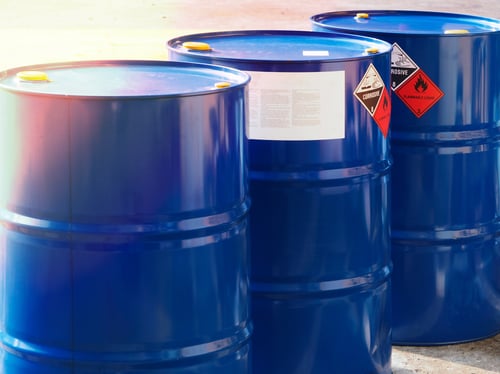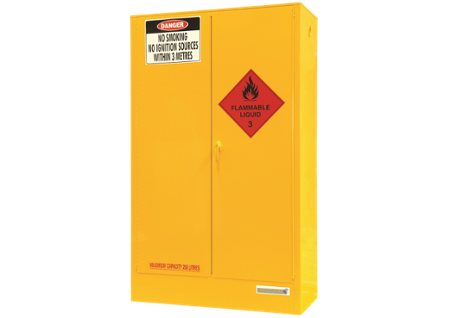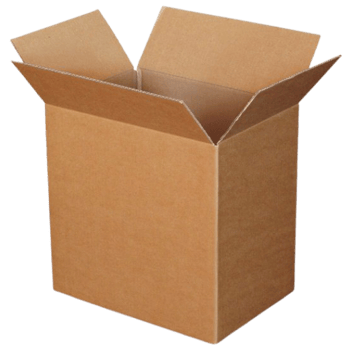So, what can I store in a flammable liquids cabinet? If this seems like a trick question, we assure you that it isn’t. Despite having a big red sign on the front of the cabinet that says Class 3 Flammable Liquids, you’d be surprised just how many times we see worksites store acid, poison, paintbrushes and petrol — all in the same cabinet. If your workers are guilty of putting other substances and materials in your cabinet, read on to find out why you should only store Class 3 Dangerous Goods in your flammable liquids cabinet.
Storing Flammable and Combustible Liquids
Your flammable liquids cabinet is designed to safely contain Class 3 Flammable Liquids and their vapours.
The cabinets have a double-walled sheet steel construction and tight-fitting doors that close automatically. This creates a heat barrier that can withstand temperatures of at least 850°C as well as provide liquid-tight spill protection.
Any highly flammable or combustible liquids may be stored inside the cabinet.
This includes, but is not limited to, chemicals such as:
- petrol & diesel
- fuel oil
- lube oil
- heating oils
- resins
- enamel paints & thinners
- ethanol
- kerosene
- acetone
- insecticides & pesticides
Requirements for Flammable Storage
Pay attention to the following essential requirements when you’re storing Class 3 Dangerous Goods inside your flammable cabinet.
1. Drums and Large Containers
There are specific requirements under Australian Safety Standards for storing drums of a larger capacity:
4.9.8 Storage in storage cabinets
The following operational requirements and recommendations apply:
(a) Persons shall be prevented from entering the cabinet.
(b) Drums shall not be stacked more than two high if they are greater than 60 L capacity.
(c) Only one drum of more than 60 L capacity should be kept in a horizontal (decanting) position at any time.
(d) Only closed packages, or those fitted with a tap, should be stored in the cabinet.

Your workplace is required to store drums that are 60 litres or larger in stacks of 2 maximum, or only 1 in the decanting position.
To summarise Section 4.9.8 off the Australian Standard, when storing drums that are more than 60 litres in capacity, your cabinet loading requirements must include that:
- Drums (60L+) are not to be placed in stacks of more than 2.
- Only one drum (60L+) is permitted to be stored in the decanting position, which is lying the drum horizontally.
2. Lids and Seals
Australian Safety Standards only permit closed packages, containers with lids in place, or containers fitted with a tap inside flammable liquids cabinets. This requirement is to prevent chemical spills and flammable vapours escaping the containers.
You should always check the integrity of containers, and their lids, before placing inside the cabinet.
Make sure you also wipe down exterior surfaces to remove chemical residues.
3. Load Capacity
Every flammable liquids cabinet has the maximum load capacity clearly marked on the front the cabinet. Never overload the cabinet as this can negate its spill containment compliance and fire safety rating.

Your flammable liquids cabinet is clearly marked with a maximum load capacity that should never be exceeded.
NOTE: According to Australian Standard AS1940:2017, aerosol cans may be placed in flammable liquids cabinets but only if the cabinet has sufficient projectile protection. We recommend that aerosols be stored in a dedicated aerosol cage that has reinforced walls and has ventilation directed suited to flammable gases.
Don’t Store Incompatible Substances
Construction specifications for flammable liquids cabinets are not necessarily suited to other classes of Dangerous Goods.
For example:
- Oxidisers — oxidisers are incompatible with flammable liquids and they should never be stored together. At the same time oxidisers need a cabinet with doors that will release if pressure builds up inside the cabinet.
- Organic peroxides — flammable liquids and organic peroxides are not compatible and should be isolated from each other. Cabinets for organic peroxides needs additional insulation and ventilation.
- Toxic substances — flammable liquids and Class 6 Toxics should be kept apart. Toxic substances must be stored in cabinets that can be fully locked.
- Corrosives — Class 8 Corrosives and flammable liquids should be kept apart. Safety cabinets for corrosive substances need corrosion free materials or a special protective coating.
- Class 4 Dangerous Goods — Class 4 substances need safety cabinets with doors that will release if pressure builds up inside the cabinet. They also have different ventilation requirements.
IMPORTANT: Always check for incompatibilities and segregation distances on the Safety Data Sheet (SDS) for every chemical and hazardous substance you hold onsite. If working space is an issue talk to our Dangerous Goods team who can help you manage all Classes of Dangerous Goods more efficiently.
Avoid Ignition Sources
It is a requirement of Australian Standard AS1940:2017 –- The storage and handling of flammable and combustible liquids that ignition sources are not to be within 3 metres of a flammable liquids cabinet.
What this means is you cannot:
- Put ignition sources inside the cabinet. Eg, matches, lighters, electronic gadgets.
- Carry out any work activities near the cabinet that could generate heat, sparks, flames, or static discharge. Eg, welding, grinding, cutting.
- Bring any item that produces sparks, flames, or static discharge near the cabinet.
- Install the cabinet near power points, light switches, and electrical appliances that could discharge and create a spark.
Never Store Combustibles
Don’t waste the space inside your flammable liquids cabinet by storing combustible items with your Class 3 Dangerous Goods. Combustibles such as paintbrushes, cleaning rags, personal protective equipment (PPE) and excess packaging — such as stretch-wrap or cardboard cartons — should never see the interior of your flammable cabinet.
 Combustibles, such as carboard packaging, should never be stored within your flammable liquids cabinet, as it negates the safety features of the cabinet being a fire protection measure.
Combustibles, such as carboard packaging, should never be stored within your flammable liquids cabinet, as it negates the safety features of the cabinet being a fire protection measure.
All of these useful — but combustible — items should instead be stored in a general purpose storage or a dedicated PPE cabinet.
REMEMBER: STOREMASTA also manufacture a range of general purpose storage equipment — from lifting boxes to lockers. Having sufficient storage equipment for sundry items discourages workers from wasting valuable space inside your high-tech flammable liquid’s cabinets.
What’s In Your Flammable Liquids Cabinet?
Do some of these examples seem a little familiar? Don’t compromise the integrity and compliance of your flammable liquids cabinet by using it to store incompatible substances, ignition sources and combustibles.
If you’re interested in keeping your workplace safe and compliant, we have created an eBook to help you reduce your risk. Essential Considerations When Storing Flammable Liquids Indoors has all the information you need to carry out a risk assessment on your chemical stores — as well as select a Class 3 Flammable Liquids cabinet. You can download our free guide and read it now by clicking on the image below.

Joining the team as a Dangerous Goods Storage Consultant, Melissa Hampton became Storemasta's Marketing Manager in late 2021. With extensive knowledge and experience in chemical compliance, Melissa is responsible for leading the Marketing team and helping shape their marketing strategy. In her spare time, you can find Melissa hiking, swimming and enjoying the great outdoors in beautiful north-west Tasmania.